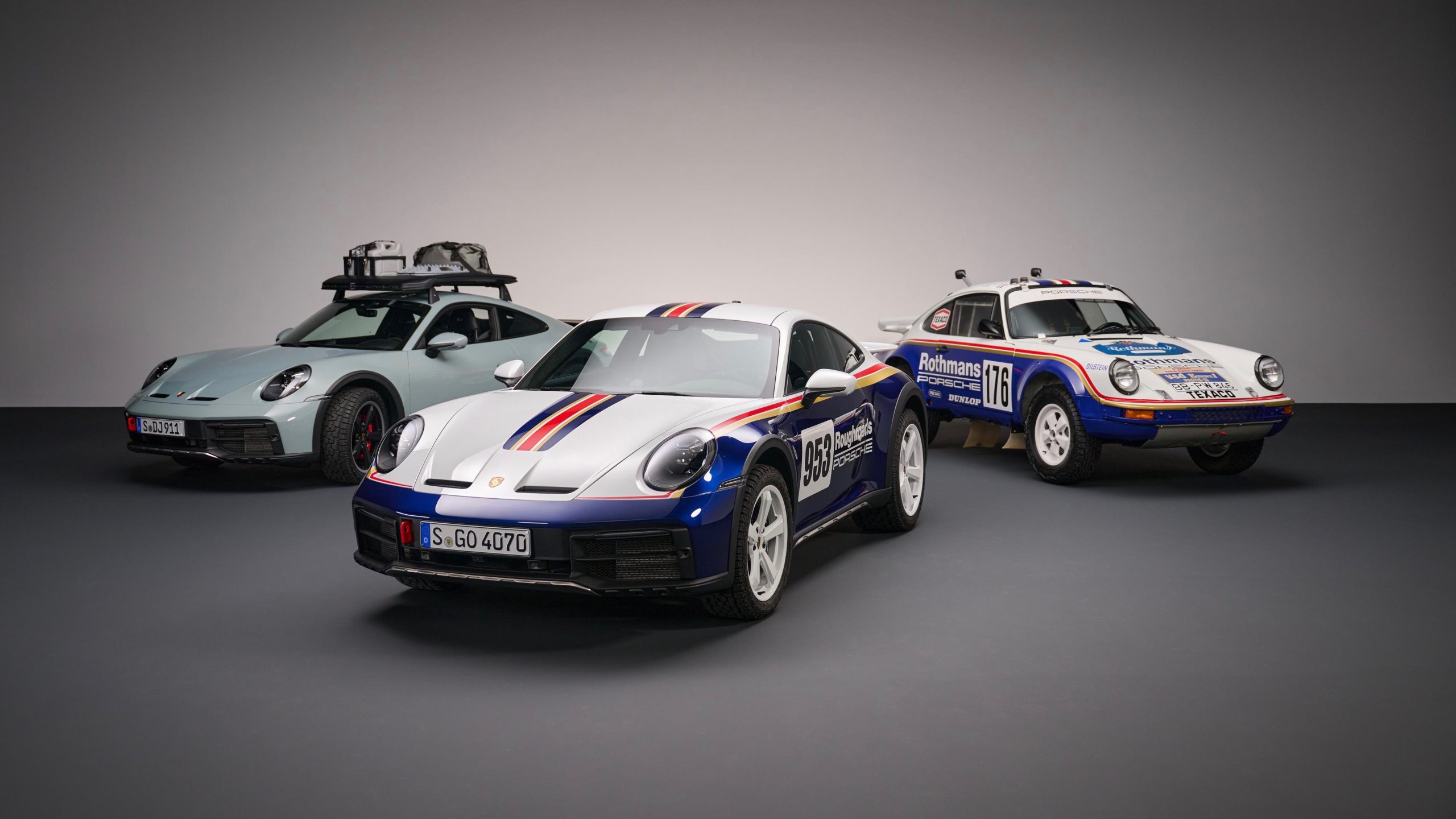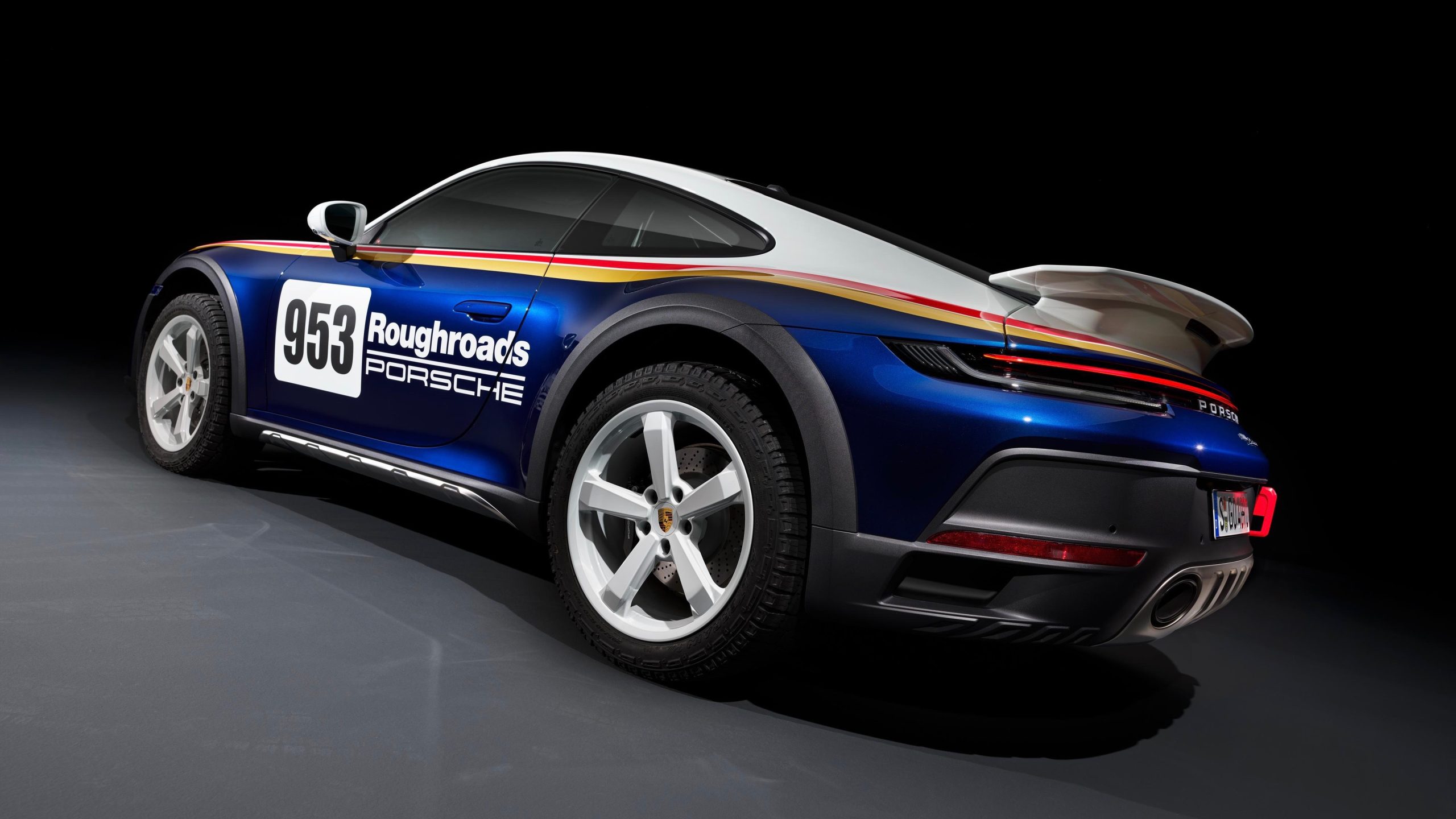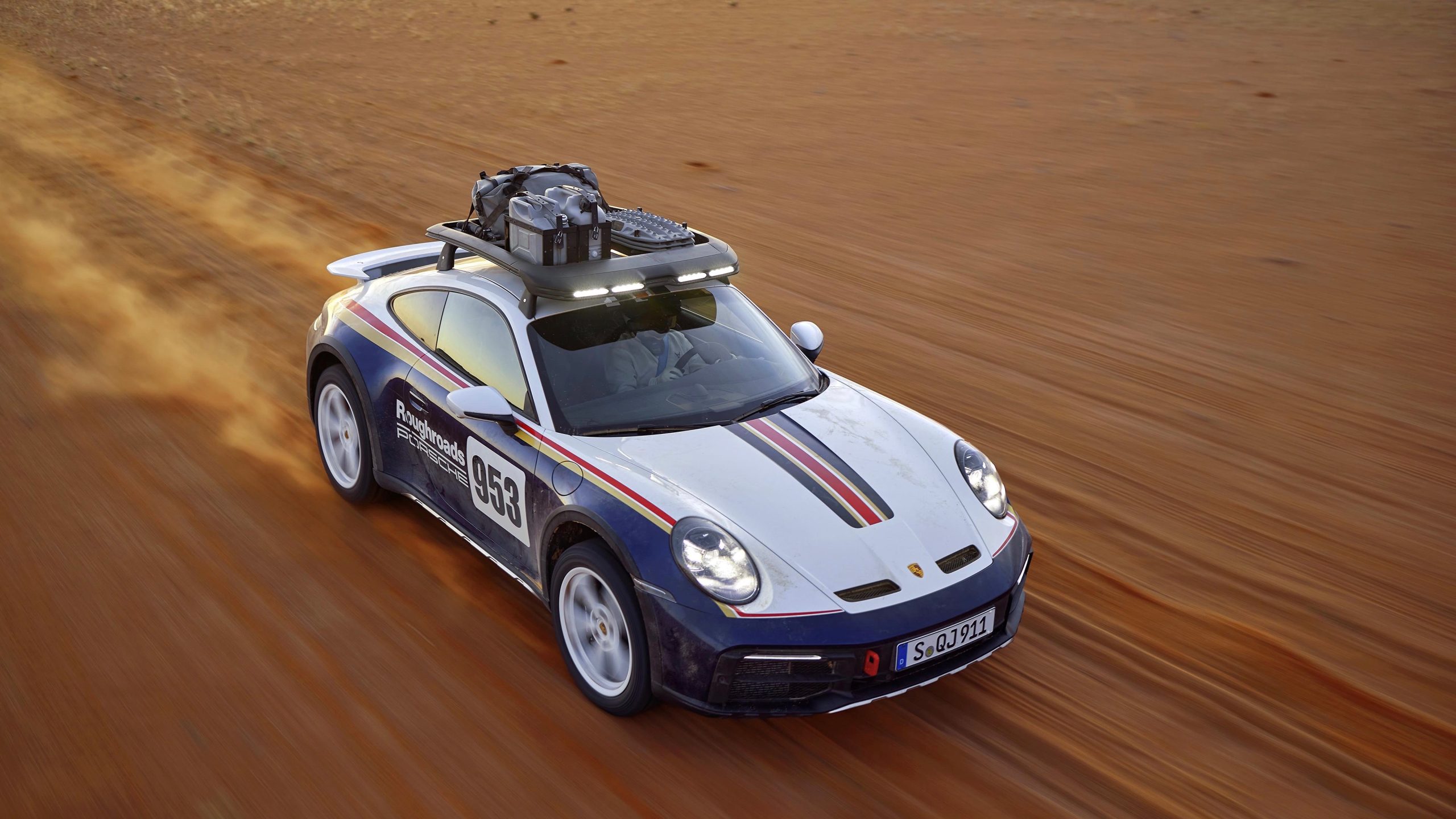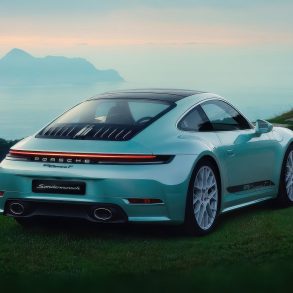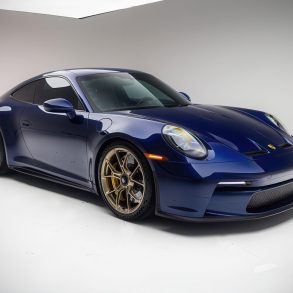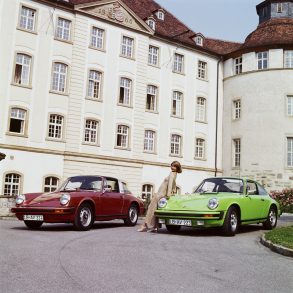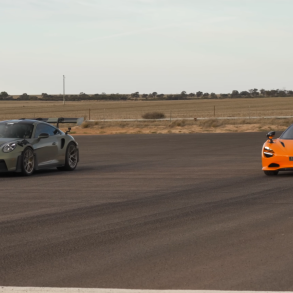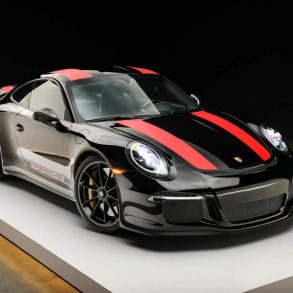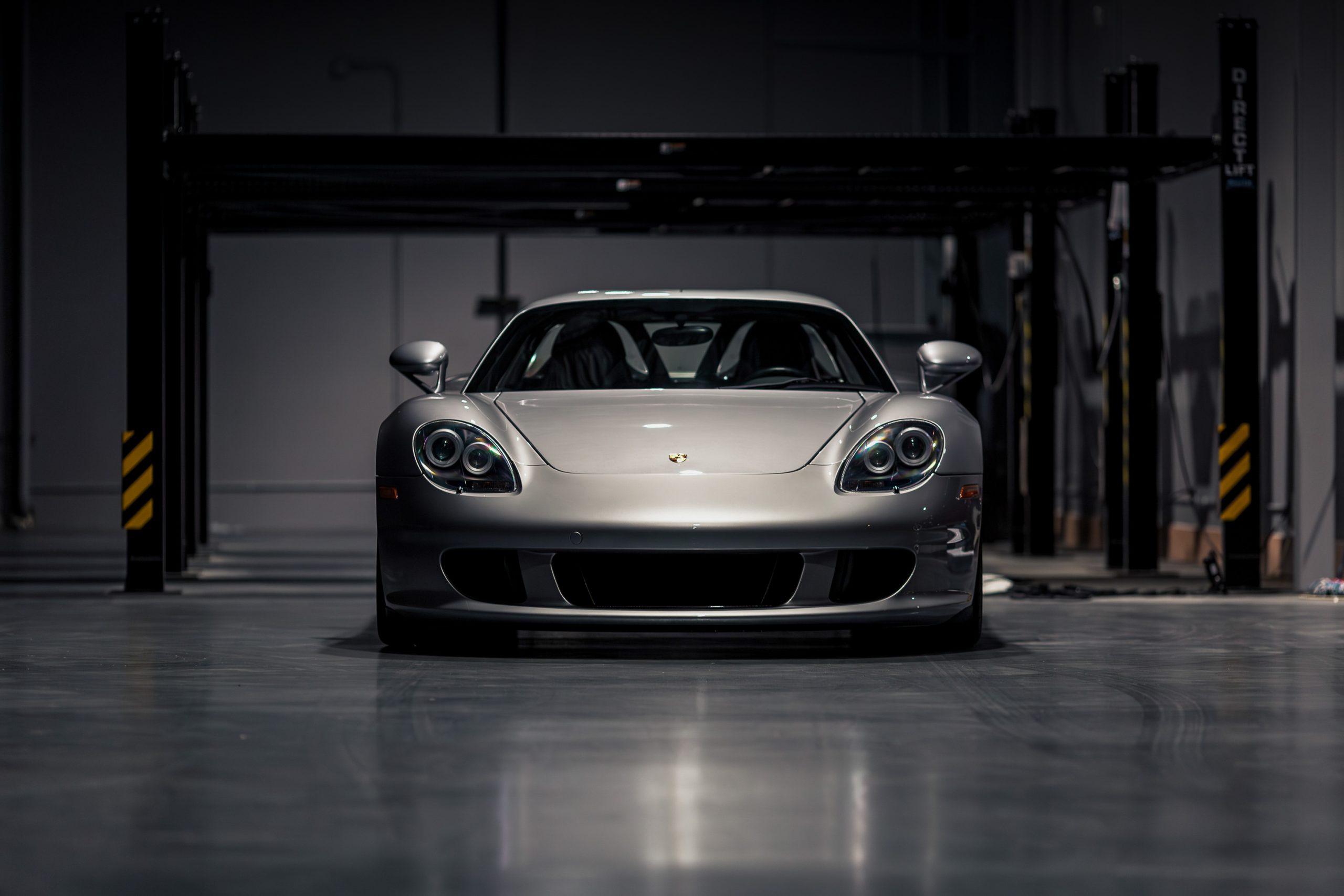2023 – 2024 Porsche 911 Dakar (992.1) – Reviews, Pricing, Specs & Buyers Guide
The Porsche 911 Dakar is a glorious contradiction: a jacked-up, skid-plate-wearing, all-terrain 911 that still launches like a GTS on tarmac and flings gravel with rally-stage exuberance. Announced at the 2022 Los Angeles Auto Show and limited to 2,500 units worldwide, the Dakar pays homage to Porsche’s 1984 Paris-Dakar victory while proving the 911 formula genuinely works far beyond smooth circuits. Below you’ll find the full story—specs, engineering highlights, how it drives, model-year details, reviews, options that matter, and buying notes.
Porsche created the 911 Dakar to celebrate the brand’s first overall win at the 1984 Paris-Dakar Rally—the event that also introduced all-wheel drive to the 911. Beyond nostalgia, the car’s mission was technical: demonstrate that a modern 911 could be engineered to work properly off-road without losing the clarity and speed that define the nameplate. Porsche made that point explicit at launch: “there are hardly any limits to the concept of the Porsche 911,” they said, while confirming the 2,500-unit cap and an optional Rallye Design Package that visually echoes the 1984 winner. U.S. cars carried a $222,000 MSRP before destination.
Powertrain, Chassis & Hardware
Engine & driveline. Under the decklid sits the familiar 3.0-liter twin-turbo flat-six tuned to 480 PS (473 hp) and 570 Nm (420 lb-ft), paired exclusively to an 8-speed PDK and all-wheel drive. Porsche quotes 0–100 km/h in 3.4 s and a top speed of 240 km/h (149 mph)—the latter limited by the all-terrain tires rather than power. Rear-axle steering, GT3-grade engine mounts, and PDCC active anti-roll control are standard.
Suspension & ground clearance. Ride height is the headline: the Dakar sits 50 mm higher than a Carrera with sport suspension, and its standard lift system adds another 30 mm front and rear for a maximum 191 mm (7.5 in) of ground clearance. Crucially, High ride height isn’t a crawl-mode party trick—the calibration allows it up to 170 km/h (106 mph) before the car lowers itself automatically. Approach, breakover, and ramp angles were rethought, with Porsche quoting an SUV-like 19° breakover angle.
Wheels & tires. For the first time on a series-production 911, Pirelli Scorpion All Terrain Plus tires are standard equipment: 245/45R19 front and 295/40R20 rear. They carry a ~9-mm tread depth with two carcass plies for cut resistance and sidewall stiffness. Porsche-specific P Zero summer and P Zero Winter options are also available for those who will spend more time on pavement.
Body & aero. Off-road duty demanded real changes: a fixed CFRP rear spoiler and GT3-style CFRP front hood; widened tracks; stainless-steel underbody, sill, and intake protection; impact-resistant plastic arch extensions; and forged-aluminum towing eyes. Porsche also removed the usual 911 front spoiler lip to improve approach angle and reshaped airflow to the intercoolers for durability in dirt. Weight-saving is thorough—rear seats are deleted, full bucket seats are standard, and lightweight glass and battery are fitted—leaving a curb mass of 1,605 kg, just 10 kg more than a 911 Carrera 4 GTS PDK.
Drive modes. Two new programs join Normal/Wet/Sport:
-
Rallye: rear-biased AWD (≈80% to the back) for loose surfaces.
-
Off-Road: defaults to maximum ride height and tighter diff locking for sand, rocks, and rough ground.
A special Rallye Launch Control allows ~20% wheel slip, so you can legitimately launch on gravel or sand with the lift at full height.
Adventure add-ons. The roof features a 12-volt socket to power an optional roof rack with auxiliary LEDs and 42-kg load rating (jerrycans, boards, shovel), and Porsche even offers a roof tent.
Performance: Numbers That Don’t Make Sense (In a Good Way)
On paper the Dakar trades a little top speed for dirt-worthiness, but independent tests show it’s still shockingly quick. Car and Driver recorded 0–60 mph in 2.9 s, the quarter-mile in 11.1 s @ 126 mph, and 0.96 g on the skidpad—on chunky AT rubber. Braking from 70 mph took 162 ft. Top speed is governed around 150 mph due to the tires.
MotorTrend’s early testing found 3.5 s to 60 mph (they also note Porsche’s 3.2-s claim), and confirmed the wonderfully silly fact that Launch Control works in Off-Road mode—the car will catapult itself with full lift engaged.
The takeaway: it’s not merely “fast for a lifted car”—it’s 911-fast, full stop.
How It Drives
On asphalt, the Dakar’s taller sidewalls and recalibrated chassis trade a sliver of ultimate crispness for fearless compliance. That’s a good deal on broken roads. Steering remains lucid, response immediate, and the flat-six’s mid-range pull makes overtakes effortless. On gravel or sand, Rallye mode sends more torque rearward, the diff logic changes, and the car rotates with the throttle like a giant rally hot-hatch—but with 911 traction. Top Gear called it “utterly joyous and addictive to drive off-road,” praising how the new modes and suspension logic open up terrain that would terrify a normal sports car. Noise levels rise with the all-terrain tread and reduced insulation, but the Dakar never feels crude. It feels purpose-built: clear, tough, and weirdly refined over surfaces that would have you bracing in most sports cars.
Design & Identity
While any color suits the shape, the Dakar introduced Shade Green as an exclusive hue and offered the headline Rallye Design Package—two-tone White/Gentian Blue Metallic with “Roughroads” door script (a cheeky stand-in for the 1984 car’s banned tobacco sponsor), red/gold stripes, and white wheels. The package is elaborate and expensive, but it’s the deepest factory nod to Porsche’s rally history on a modern 911. Inside, Race-Tex (Alcantara-like) surfaces, unique trim, and the absence of rear seats remind you this is a focused edition. Bucket seats are standard; the rest of the ergonomics are familiar 992.
Model-Year Coverage & Production
- 2023 (launch year): First U.S. deliveries in spring; MSRP $222,000 + destination. Core spec as above. Optional Rallye Design Package debuts.
- 2024: Carry-over spec (992.1) as Porsche completes the 2,500-unit production run. Various markets reported sold-out allocations early. (Porsche’s press materials consistently reference the 2,500-unit cap.)
(Note: Some outlets reported the end of production in late 2024 after the 2,500 were built; Porsche’s own launch material is the definitive source for the 2,500 figure.)
Reception & Reviews
- Car and Driver (instrumented test): 0–60 2.9 s, 11.1 @ 126 mph quarter, 0.96 g skidpad—a “rub some dirt on it” supercar that still behaves like a 911 on a track sheet.
- MotorTrend (first/dirty test): Validates real performance on and off road, notes Porsche’s 3.2-s claim and its own 3.5-s best; applauds configurable modes and the novelty (and effectiveness) of Rallye Launch Control.
- Top Gear (first drive): Calls the car “utterly joyous and addictive to drive off-road,” highlighting Rallye and Off-Road torque splits and the way the chassis encourages play on loose surfaces.
- Pirelli engineering note: AT tires were built specifically for the Dakar, with Scorpion All Terrain Plus as OE fitment and P Zero summer/winter alternatives developed exclusively, underscoring how holistic the program is.
The consensus: not a gimmick. It’s a cohesive, factory-engineered answer to the question “what if a 911 didn’t avoid the rough stuff?”
Options & Packages That Matter
- Rallye Design Package. The two-tone White/Gentian Blue look with “Roughroads” script is the collectible spec and a major aesthetic differentiator. It’s also pricey, which is part of why many cars stickered well above base. (Contemporary reporting pegs it at roughly $28,470 in the U.S.)
- Roof rack & tent. Not just cosplay—the rack has a 42-kg capacity and integrated 12-V power for lights. The roof tent turns the Dakar into a two-person overlander (in style).
- Wheels/tires. Factory ATs are part of the car’s identity. Porsche-spec P Zero options exist if you’ll primarily road-drive; just remember that the 149–150 mph limiter reflects AT fitment. Swap rubber, and your experience—grip, noise, wet behavior—changes meaningfully.
- Colors. Shade Green is Dakar-exclusive; Paint-to-Sample cars also exist and can be stunning (and expensive).
Buying Guide (New/Used)
- Verify authenticity & spec. Ask for the build sheet confirming 911 Dakar (not a standard 992 with aftermarket lift), transmission (PDK only), rear-seat delete, bucket seats, and any factory options (Rallye Design, rack/tent, wheel packages). The U.S. press kit and Porsche configurator screenshots in the file set are helpful for cross-checking equipment.
- Inspect the underbody & protection. Stainless skid plates, arch extensions, and the front/rear tow eyes can tell stories about usage. Light gravel rash is normal; deep gouging, bent mounts, or cracked plastics suggest harder impacts.
- Tires & alignment. AT tires wear and “feather” differently if driven hard on tarmac; confirm even wear and budget for replacements (and possibly a street set if you’ll daily it). Have a recent alignment printout—geometry matters to the 911’s feel.
- Cooling & intakes. The Dakar uses stronger side-module fans and stone-guarded intakes. Make sure the grilles are intact and free from debris after any serious dirt play.
- Roof gear. If the car has a roof rack or tent, inspect mounts, seals, and electrical lead for the light bar; confirm weight wasn’t exceeded.
- Collectibility cues. Rallye Design cars, Shade Green, complete accessory kits, and delivery collateral (window sticker, books, rack bits, maybe even the period-style wraps Porsche offered) tend to attract the most attention.
Living With a Dakar
- Daily drivability. Taller sidewalls, recalibrated PASM, and the lift transform bad pavement into no big deal. The cabin is 992-familiar, but rear seats are gone, and AT tires add road noise.
- Fuel economy. Unsurprisingly worse than a slick-tired 911; C/D observed 13 mpg overall and 29 mpg highway in their test cycle—a reminder that aero/rolling resistance matter.
- Maintenance. It’s still a 992 at heart—routine service is straightforward—but plan for AT tire costs and more frequent inspections if you regularly drive on dirt/sand.
Where It Fits in the 992 Line
Think of the Dakar as the adventure twin to the track-obsessed GT3 and the autobahn-devouring Turbo: same 992 DNA, radically different brief. It’s closest mechanically to a Carrera 4 GTS but taller, tougher, and lighter in places, with specific tires, protection, and software to make loose-surface driving natural—not merely possible. It’s also a bookend for the 992.1 era (before 992.2 hybridization in other trims), and that timing will matter to some collectors.
Quick Specs (U.S./Global Highlights)
- Years: 2023–2024 (992.1)
- Production: 2,500 units (global)
- Engine: 3.0-L twin-turbo flat-6; 480 PS (473 hp); 570 Nm (420 lb-ft)
- Transmission: 8-spd PDK (AWD)
- 0–62 mph: 3.4 s (factory); 0–60 mph 2.9 s tested (C/D)
- Top speed: 240 km/h | 149–150 mph (tire-limited)
- Ride height: +50 mm vs. sport-susp Carrera; +30 mm via lift (to 191 mm)
- Tires (std): Pirelli Scorpion All Terrain Plus; 245/45R19 F, 295/40R20 R
- Curb weight: 1,605 kg (about 10 kg over a C4 GTS PDK)
Verdict
The 911 Dakar isn’t a sticker pack; it’s a thorough, engineering-led rethink of the 911’s operating envelope. The lifted suspension, reworked aero/protection, tire development, new drive modes, and weight strategy add up to a sports car that embraces bad surfaces and still feels unmistakably like a 911 the instant you turn the wheel. If you want Nürburgring numbers or absolute top-speed bragging rights, a GT3 or Turbo is the cleaner choice. But if your dream 911 involves fire roads, snow days, and smashed-to-rubble tarmac—without forfeiting pace—the Dakar is not only viable, it’s intoxicating. Among modern special 911s, the Dakar is one of the rare few that rewrites where a 911 can be brilliant. And it does so with skill, humor, and a shower of gravel.
What We Said At Launch
The new special edition Porsche 911 Dakar is equally at home on loose surfaces as it does on country roads. The exclusive model limited to 2,500 units globally demonstrates that the concept of the Porsche 911 knows almost no boundaries. It harks back to the first overall Porsche victory at the 1984 Paris-Dakar Rally – which also represents the first use of the all-wheel drive system in a Porsche 911. To commemorate this achievement, the new 911 Dakar will be offered with an optional Rallye Design Package inspired by the iconic winning car of 1984.
Standing tall, sliding sideways
The first thing that immediately stands out on the Porsche 911 Dakar is its ride height: It is 50 millimeters higher than on a 911 Carrera model equipped with Sport Suspension. In addition to this, the standard lift system can raise the front and rear of the car by an additional 30 mm – achieving a level of ride height and ramp-over angles similar to conventional SUVs. The lift system is not only designed to help clear obstacles at low speeds, but is also an integral component of the newly calibrated suspension. The “High Level” setting is usable at up to approximately 105 mph for spirited off-road driving. Above this speed, the car returns to its normal ride height.
Specially developed Pirelli Scorpion All Terrain Plus tires, measuring 245/45 ZR 19 in front and 295/40 ZR 20 at the rear complement the especially sporty off-road appearance of the new model. The off-road focused tread pattern has a depth of nine millimeters, the reinforced sidewalls and tread have dual carcasses, making them suitable for off-road excursions and more resistant to sidewall damage. Summer performance tires and snow tires from the Pirelli P Zero tire family are optionally available, and also feature dual carcass layers, but the new all-terrain tires are standard equipment.
Powerful engine for all surfaces
The 3.0-liter twin-turbo Boxer engine makes 473 hp and 420 lb.-ft. of torque and delivers commanding performance accompanied by the unmistakable Boxer engine sound. The new 911 Dakar accelerates from 0 to 60 mph in 3.2 seconds, the top track speed is limited to 150 mph due to the cross section height of the tires for this model.
The engine is paired with an eight-speed-PDK and Porsche Traction Management (PTM) all-wheel drive. Rear-axle steering, engine mounts adopted from the 911 GT3 and the body roll reducing Porsche Dynamic Chassis Control (PDCC) system are also standard equipment. The interplay of all these components enables the 911 Dakar to tackle sand and loose gravel especially well. Two new drive modes – Rallye Mode and Off-Road Mode – offer the excellent off-road performance that can be activated using the mode switch on the steering wheel. Rallye Mode is programmed for loose, uneven surfaces and biases power to the rear axle. In Off-Road Mode, which is focused on maximizing traction on sand and in rough terrain, the “High Level” ride height is automatically engaged. A new Rallye Launch Control mode was developed specially for this model and is available in both model-specific drive modes. It enables impressive acceleration on loose surfaces and allows wheel spin of up to 20 percent.
Optional roof basket and tent
The 911 Dakar also features a fixed rear spoiler, and a hood made of CFRP, of which the latter is taken from the 911 GT3, with large openings designed to extract air. Red front and rear tow hooks made of forged aluminum, flared fender arches and rocker panels contribute to the off-road appearance as do stainless steel body elements on the front and rear fascia and side skirts. The side air intakes in the newly designed front fascia also have stainless steel mesh grilles to rocks and other damaging objects from entering.
The roof of the 911 Dakar is equipped with a 12-volt-socket for the headlights of the optional roof basket. It can hold up to 92 lbs. of equipment such as spare gas and water canisters, folding shovels and recovery boards. A roof tent is available for the 911 Dakar as well.
The interior of the 911 Dakar underscores the performance-oriented nature of the car with standard Full Bucket Seats and deleted rear seats. Lightweight glass also helps save mass so that the 911 Dakar has a curb weight of 3,552 lbs. – just 16 lbs. more than a 911 Carrera 4 GTS with PDK.
Another Dakar-specific detail is the standard Race-Tex upholstery with decorative stitching in Shade Green, which is exclusive to the 911 Dakar as an exterior paint color.
Rallye Design Package harks back to Dakar winner of 1984
The optional Rallye Design Package starts with a two-tone paint consisting of White and Gentian Blue Metallic. This also represents the first time that Porsche is combining a two-tone paint color with decorative livery. Customers can opt for a start number on the side of the car between “0” and “999.” Customers of the 911 Dakar can order an exclusive Porsche Design Chronograph 1 ‒ 911 Dakar or the Chronograph 1 ‒ 911 Dakar Rallye Design Edition. For the first time, the housing is made of particularly light and scratch resistant titanium carbide.
The Porsche 911 Dakar is expected to begin arriving in U.S. dealers in Spring 2023, with a starting MSRP of $222,000 excluding $1,450 for delivery, processing and handling.
Pictures
Videos & Reviews
Press Release
The new Porsche 911 Dakar
November 17, 2022
Porsche is celebrating an extraordinary world premiere at the Los Angeles Auto Show: the new Porsche 911 Dakar is just as comfortable off-road as it is on the highway.
The exclusive model, limited to 2,500 units, not only shows that there are hardly any limits to the concept of the Porsche 911. It also evokes the first overall victory by Porsche in the 1984 Paris-Dakar Rally, which was simultaneously the birth of all-wheel drive in the Porsche 911. This is why the new 911 Dakar is also offered with an optional Rallye Design Package, reminiscent of that iconic winning car.
The first striking detail of the Porsche 911 Dakar is its ground clearance, which is 50 millimetres higher than that of a 911 Carrera with sports suspension. And the standard lift system can raise the front and rear ends an additional 30 millimetres. Its ground clearance and ramp angle rival those of conventional SUVs. The lift system is not only used to slowly cross obstacles, but is an integral part of the retuned chassis. The ‘high level’ setting is available for ambitious off-road adventures at speeds of up to 170 km/h. Above that speed, the car automatically lowers back down to its normal level.
Complementing the car’s sporty off-road attributes are specially developed Pirelli Scorpion All Terrain Plus tyres (sized 245/45 ZR 19 at the front and 295/40 ZR 20 at the rear). The chunky tread pattern is nine millimetres deep and the reinforced sidewalls and the threads consist of two carcass plies. All this makes the tyres of the Porsche 911 Dakar ideal even for challenging terrain and they are highly cutresistant. Pirelli P Zero summer and winter tyres are available as an option, also with two carcass plies. But the all-terrain tyres come as standard and offer sports car dynamics on the road as well.
Commanding power on all surfaces
The three-litre biturbo six-cylinder with 480 PS (353 kW, 911 Dakar: Fuel consumption* combined (WLTP) 11.3 l/100 km, CO emissions* combined (WLTP) 256 g/km, Fuel consumption* combined (NEDC) 10.5 l/100 km, CO emissions* combined (NEDC) 239 g/km) and a maximum torque of 570 Newton metres delivers superior performance with a compelling boxer sound. The new sports car sprints to 100 km/h in 3.4 seconds; due to the all-terrain tyres the top speed is limited to 240 km/h. As standard, the engine comes with an eight-speed PDK and Porsche all-wheel drive. The standard equipment also includes rear-axle steering, the engine mounts from the 911 GT3, and PDCC anti-roll stabilisation. The interplay of all the components results in the 911 Dakar being just as dynamic on sand and loose surfaces as it is on the Nürburgring Nordschleife. Maximum off-road performance is also ensured by two new driving modes, which can be selected using the rotary switch on the steering wheel. Rallye mode is ideal for loose, uneven surfaces and features rear-focused all-wheel drive. In Offroad mode the high clearance is activated automatically. This mode is designed for maximum traction on difficult terrain and on sand. Both of the new driving modes also feature the new Rallye Launch Control, which enables impressive acceleration on loose surfaces and allows wheel slippage of around 20 per cent.
Optionally with roof basket or roof tent as well as Porsche Design chronograph
Additional characteristic features of the 911 Dakar include the newly developed, fixed lightweight rear spoiler made of CFRP and the CFRP front luggage compartment lid with striking air outlets taken from the 911 GT3. There are also standard off-road details such as the red aluminium towing lugs at the front and back, the widened wheel wells and sills and the stainless steel protective elements on the front, rear and side sills. The side air intakes on the redesigned front end are also protected against flying rocks by stainless steel grilles.
The roof of the Porsche 911 Dakar features a visible 12-volt power outlet for the headlights of the optional roof rack. With a capacity of 42 kilograms, the rack can accommodate rallying equipment such as fuel and water canisters, folding shovels and traction boards without any problems. A roof tent is also available for the 911 Dakar.
In the interior, the 911 Dakar underscores its sporting ambitions with standard full bucket seats and the omission of the rear seats. Lightweight glass and a lightweight battery reduce its weight further, enabling the Porsche 911 Dakar to weigh in at just 1,605 kg – a mere 10 kg heavier than the 911 Carrera 4 GTS with PDK.
A defining feature of the Dakar interior is the standard Race-Tex surfaces with decorative stitching in Shade Green, which is also exclusively available as a metallic exterior finish for the 911 Dakar. The Rallye Sport Package with roll-over bar, six-point seat belts and fire extinguisher is optional.
Rallye Design Package with styling that echoes that of the 1984 Paris-Dakar-winning rally car
At the heart of the optional Rallye Design Package from Porsche Exclusive Manufaktur is a two-tone paint finish in White/Gentian Blue Metallic. This is the first time that Porsche has implemented the combination of bi-colour paint and decorative foiling in series production. On the side of the vehicle, the customer can choose an individual race number between 0 and 999. In addition to the rally stripes in red and gold, the 911 Dakar with Rallye Design Package, whose appearance is based on the winning vehicle of the 1984 Paris-Dakar Rally, also bears the “Roughroads” lettering on the doors. The term is a registered trademark and reflects the concept of the 911 Dakar and its suitability for driving off-road. The white-painted rims and the red taillight strip, in contrast to the standard vehicle, round off the distinctive appearance. Further highlights can be found in the interior: Extended Race-Tex and leather surrounds as well as seat belts and accents in Sharkblue.
Porsche Design Chronograph
911 Dakar customers can exclusively order the Porsche Design Chronograph 1 911 Dakar or the Chronograph 1 911 Dakar Rallye Design Edition to match the vehicle. For the first time, the housing is made of particularly scratch-resistant and light titanium carbide.




